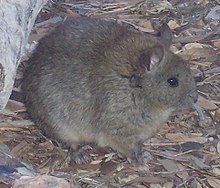| Greater stick-nest rat | |
|---|---|

| |
| Scientific classification | |
| Domain: | Eukaryota |
| Kingdom: | Animalia |
| Phylum: | Chordata |
| Class: | Mammalia |
| Order: | Rodentia |
| Family: | Muridae |
| Genus: | Leporillus |
| Species: | L. conditor
|
| Binomial name | |
| Leporillus conditor (Sturt, 1848)[3]
| |

| |
The greater stick-nest rat (Leporillus conditor), also known as the housebuilding rat[4] and wopilkara,[5] is a species of rodent in the family Muridae. They are about the size of a small rabbit and construct large nests of interwoven sticks. Once widespread across southern Australia, the population was reduced after European colonisation to a remnant outpost on South Australia's Franklin Islands. The species has since been reintroduced to a series of protected and monitored areas, with varying levels of success.[6]
- ^ Woinarski, J.; Burbidge, A.A. (2016). "Leporillus conditor". IUCN Red List of Threatened Species. 2016: e.T11634A22457522. doi:10.2305/IUCN.UK.2016-2.RLTS.T11634A22457522.en. Retrieved 12 November 2021.
- ^ "Appendices | CITES". cites.org. Retrieved 14 January 2022.
- ^ Cite error: The named reference
Sturt1848was invoked but never defined (see the help page). - ^ "Stick-nest rat, house building rat (Leporillus conditor) / Australian National Parks and Wildlife Service". Trove. 18 October 2020.
- ^ "Greater Stick-nest Rat - profile | NSW Environment, Energy and Science". www.environment.nsw.gov.au. Retrieved 18 October 2020.
- ^ Short, Jeff; Copley, Peter; Ruykys, Laura; Morris, Keith; Read, John; Moseby, Katherine (8 October 2019). "Review of translocations of the greater stick-nest rat (Leporillus conditor): lessons learnt to facilitate ongoing recovery". Wildlife Research. 46 (6): 455–475. doi:10.1071/WR19021. ISSN 1448-5494. S2CID 203389727.
